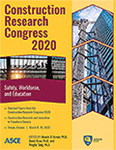Construction Research Congress 2020
Assessing the Need for Infrastructure Education within Construction Related Curriculum
Publication: Construction Research Congress 2020: Safety, Workforce, and Education
ABSTRACT
According to the most recent ASCE Infrastructure Report Card, there is a significant need to increase the level of effort and resources necessary to improve the nations aging infrastructure. Three general solutions have been proposed, and include investment, leadership and planning, and preparing for the future. Although these solutions require action at multiple levels across a broad spectrum, one area for change is within construction related curriculum. Unfortunately, many academic institutions have siloed construction and civil engineering programs, with minimal curriculum overlap. Much like the increase in integrative project delivery systems, where owners, contractors, and designers communicate more effectively, one specific academic need in addressing this issue is getting these different programs to also communicate more effectively regarding infrastructure education. This paper explores the current status of infrastructure content within construction and civil engineering related curriculum and identifies the need for enriching the infrastructure content within.
Get full access to this article
View all available purchase options and get full access to this chapter.
REFERENCES
Ahn, Y. H., Annie, R. P., & Kwon, H. (2012). “Key Competencies for U.S. Construction Graduates: Industry Perspective.” J. Prof. Issues Eng. Educ. Pract., 138(2): 123-130,.
Arlett, C., Lamb, F., Dales, R., Willis, L., and Hurdle, E. (2010). “Meeting the Needs of Industry: the Drivers for Change in Engineering Education.” Eng. Educ., 5(2): 18-25,.
ASCE (2007). “The Vision for Civil Engineering in 2025.” The American Society of Civil Engineers, Reston, VA. https://doi.org/10.1061/9780784478868.001.
ASCE (2008). “Civil Engineering Body of Knowledge for the 21stCentury: Preparing the Civil Engineering for the Future.” The American Society of Civil Engineers, Reston, VA. https://doi.org/10.1061/9780784409657.
ASCE (2016). “Failure to Act. Closing the Infrastructure Investment Gap for America’s Economic Future.” The American Society of Civil Engineers, Reston, VA. https://www.infrastructurereportcard.org/the-impact/failure-to-act-report/ (Jul. 31, 2019).
ASCE (2017). “Infrastructure Report Card.” The American Society of Civil Engineers. Reston, VA. https://www.infrastructurereportcard.org/ (Jul. 31, 2019).
Bonasso, S. G. (2001). “Engineering, Leadership, and Integral Philosophy.” J. Prof. Issues Eng. Educ. Pract., 127(1): 17-25.
Bordogna, J. (1998). “Tomorrow's Civil Systems Engineer – The Master Integrator.” J. Prof. Issues Eng. Educ. Pract., 124(2): 48-50.
CIT-E (2019). “Model Introductory Infrastructure Course.” http://www.cit-e.org/ (Jul. 31, 2019).
Elzomor, M., Burke, R., Parrish, K., & Gibson, G. E. (2018). “Front-End Planning for Large and Small Infrastructure Projects: Comparison of Project Definition Rating Index Tools.” J. Manage. Eng., 34(4): 04018022,.
Esmaeili, B., Parker, P. J., Hart, S. D., Mayer, B. K., Klosky, L., and Penn, M. R. (2017). “Inclusion of an Introduction to Infrastructure Course in a Civil and Environmental Engineering Curriculum.” J. Prof. Issues Eng. Educ. Pract., 143(2): 04016020,.
Gordon, C. (1999). “Educational Requirements for Civil Infrastructure Managers: What Should They Know and When Should They Know It?” Public Works Manage. and Policy, 4(1): 81-88.
Grigg, N. S. (2000). “Where are we in infrastructure Education?” Public Works Manage. and Policy, 4(3): 256-259.
Grigg, N. S. (2013). “Infrastructure Stimulus Spending: Lessons for Assessment and Engineering Education. J. Prof. Issues Eng. Educ. Pract., 139(2), 81-86,.
Grigg, N. S., Andersen, C. F., Daniels, J. Z., Gessler, J., and Levine, A. (1997). “Women in Public Works: The Engineering Pipeline.” Public Works Manage. and Policy, 2(2): 121-128.
Haden, C., Parker, P. J., Thompson, M. K., Penn, M. R., Hart, S. D., and Roberts, M. W. (2016). “Implementation of Infrastructure Education Courses across Multiple Institutions.” Proc. ASEE Annual Conf., New Orleans, LA.
Hart, S. D., Klosky, J. L., Hanus, J. P., Meyer, K. F., Toth, J. A., and Reese, M. (2011). “An Introduction to Infrastructure for All Disciplines.” Proc. ASEE Annual Conf., Vancouver, B.C., Canada.
Kirschenman, M. D., and Fasano, A. (2012). “Developing Engineering Leaders.” Leadership Manage. Eng., 12(3): 189-191,.
Klosky, J. L., Katalenich, S. M., and Hart, S. D. (2012). “Requiring a Course in Infrastructure for All Graduates.” Proc. ASEE Annual Conf., San Antonio, TX.
Krupczak, J., & Ollis, D. (2008). “Technology Courses for Undergraduates: Developing Standard Models.” Proc. ASEE Annual Conf., Pittsburgh, PA.
Little, R. G. (1999). “Educating the Infrastructure Professional: A New Curriculum for a New Discipline.” Public Works Manage. and Policy, 4(2): 93-99.
Mostafavi, A., Huff, J. L., Abraham, D. M., Oakes, W. C., and Zoltowski, C. B. (2016). “Integrating Service, Learning, and Professional Practice: Toward the Vision for Civil Engineering in 2025.” J. Prof. Issues Eng. Educ. Pract., 142(3): B4013001.
Parker, P. J., Haden, C., Hart, S. D., Thompson, M. K., and Roberts, M. W. (2014). “Creating and Infrastructure Education Community of Practice.” Proc. ASEE Annual Conf., Indianapolis, IN.
Penn, M. R. and Parker, P. J. (2012). Introduction to Infrastructure: An Introduction to Civil and Environmental Engineering, John Wiley and Sons, Hoboken, NJ.
Richter, D. M. and Paretti, M. C. (2009). “Identifying Barriers To and Outcomes of Interdisciplinarity in the Engineering Classroom.” European J. of Eng. Educ., 34(1): 29-45.
Roberts, M. W., Parker, P. J., Thompson, M. K., and Barnet, B. A. (2011). “Development of an Introduction to Infrastructure Course.” Proc. ASEE Annual Conf., Vancouver, B.C., Canada.
Russell, J. S. and Stouffer, W. B. (2005). “Survey of the National Civil Engineering Curriculum.” J. Prof. Issues Eng. Educ. Pract., 131(2): 118-128.
Toole, T. M. (2011). “Internal Impediments to ASCE’s Vision 2025.” Leadership Manage. Eng., 11(2), 197-207.
U.S. Census Bureau (2019). “Monthly Construction Spending, May 2019.” https://www.census.gov/construction/c30/pdf/release.pdf (Jul. 31, 2019).
Information & Authors
Information
Published In
Construction Research Congress 2020: Safety, Workforce, and Education
Pages: 688 - 696
Editors: Mounir El Asmar, Ph.D., Arizona State University, David Grau, Ph.D., Arizona State University, and Pingbo Tang, Ph.D., Arizona State University
ISBN (Online): 978-0-7844-8287-2
Copyright
© 2020 American Society of Civil Engineers.
History
Published online: Nov 9, 2020
Published in print: Nov 9, 2020
Authors
Metrics & Citations
Metrics
Citations
Download citation
If you have the appropriate software installed, you can download article citation data to the citation manager of your choice. Simply select your manager software from the list below and click Download.
